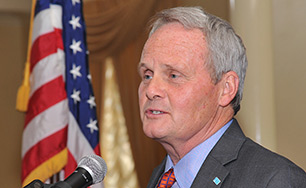The Four Core Beliefs of Enterprise by Lawrence W. Reed & Wayne Olson [+Video]
How to solve complex business problems.
The term tunnel vision carries such a negative connotation that no one ever really wants it, even if they’re traveling through a tunnel. We say we want to be conscious of as much of our surroundings as possible, not simply a narrow sliver. We want to perceive all the relevant factors and remain aware of new things that might improve our situation.
Alas, that’s almost always easier said than done.
Just ask Bartley J. Madden, author of a new, 122-page book, Reconstructing Your Worldview. Better yet, if you’re an aspiring entrepreneur, read the book and visit his website LearningWhatWorks.com, or watch this insightful video:
Madden has spent decades trying to understand the business world during his career in money management, investment research, and university teaching. His longtime fascination with methods of solving complex business problems led him to realize that the way we say we want to see the world and the way we actually do are two very different things. It takes a conscious, thoughtful effort to open wide our mind’s eye, so to speak. If you learn to do it systematically, the result can be a new worldview that will reshape how you notice opportunities and capitalize on them.
Nearly 40 years ago, we heard Austrian economist Israel Kirzner lecture on his specialty, entrepreneurship. He employed an analogy we’ll never forget. He asked his audience to imagine a free, dynamic economy as a place where a quiet blizzard of 10-dollar bills is raging just overhead. Most people never notice it, but one very special kind of person does: the entrepreneur. He sees the bills and musters the courage to reach up and grab one. In other words, he deploys his “entrepreneurial alertness” to seize an opportunity: to buy low and sell high, to assemble factors of production to make a product or service worth more than its input costs, or to move a good from one place to another where it’s more desired. Perhaps an even more apt analogy would be a blizzard in which most of the flying bills are fake and worthless, and only a few are “winners.” But in any event, it’s the entrepreneur whose powers of observation are great enough to see any of them at all.
Entrepreneurial alertness is essentially what Madden implores us to cultivate. We must start by recognizing what he calls “the four core beliefs” we need to solve problems in business:
- Past experiences shape our current assumptions.
- Language is perception’s silent partner.
- Improving any system’s performance requires that we identify and fix its key constraints.
- Human behavior is purposeful; we act not simply in response to stimuli (much as a ball rolls in the direction in which it’s pushed) but in a conscious, living fashion. We compare our actual experiences to our preferred experiences and then act to create new experiences that come as close to the preferred ones as possible.
These four core beliefs are more profound than Madden believes we commonly assume.
Each teaches a vital lesson. On a whole, their underlying message for economics concerns how innovation develops when the market is open to new entrants. Established businesses get caught up in the same old ways of looking at the world and the opportunities for value creation. So do government bureaucracies, but the difference is that government bureaucracies tend to institutionalize the conventional ways of looking at the world and create barriers to anyone trying to change them; private industries who fail to change will be swept away.
The book is thoroughly researched and rich with citations that allow the reader to pursue the subject in depth. Madden even delves into how people form beliefs and act on them, using the latest findings.
He beautifully illustrates the first two of the four core beliefs with a Kmart-versus-Walmart example. Kmart’s management had in their minds the word “store” and defined it in ways they’d always seen a “store” behaving and delivering profitable results for them: freestanding and run independently by its own manager. So they stuck to that business model, namely: put a big box in a big town and assume that is necessary for generating the desired economies of scale. In contrast, as Madden explains, “in Sam Walton’s worldview, each store was an integrated part of a networked system” that could create value in the wide-open small-town markets.
A “worldview” is not about one innovative idea that turns out well, but about openness to experimentation and knowledge building. Madden continues, “Walmart’s networked system of stores and distribution centers resulted in fast-paced learning and high efficiencies.… Over time, Walmart greatly expanded and improved its business processes at a far more rapid pace than did Kmart,” eventually leaving Kmart in the dust, even in the larger towns.
The third core belief is that in order to make a complex process create more value, it’s not enough to pick individual components and improve them; you have to identify where the constraints are in the process. If the bottleneck is at process B in the production line, improving the efficiency of process A will merely increase the size of the problem at process B. The problem is that the managers of process A in centralized operation have every incentive to propose “improvements” that actually create no value.
Madden follows this thought to an in-depth discussion of the merits of distributed systems over centrally planned systems, including “lean thinking” concepts, where he makes this key point: “A lean culture has a horizontal orientation in order to better coordinate work and reduce waste along the entire value streams that end with the customers.… In contrast, a command-and-control orientation is composed of vertical silos with incentives to improve local efficiencies.”
Placing this belief in a much broader context, he observes that “nature has a propensity for distributed solutions” and, echoing Hayek, “when a society’s institutions evolve through a naturally “evolutionary” process, rather than one of an imposed human design, the result tends to reflect decentralization and a selection of whatever works best.”
The fourth core belief should appeal to all those who have read Ludwig von Mises’s magnum opus, Human Action or are even moderately familiar with the central insights of the Austrian school that Mises represents. When you’re dealing with people, you’re dealing with independent actors who will respond to stimuli according to their own “control systems,” which Madden likens to a thermostat. Their reaction to something depends on whether it will move them closer to a desired state that represents their goals. So you can’t ignore the incentives — you can’t move people around like pieces on a chessboard, as Adam Smith’s central-planning “man of system” tries to do.
This is where government programs almost always fall down, but Madden makes it clear that private businesses can easily fall into the same trap if they’re not mindful — in which case, the market gives them the feedback that they’ve made a mistake, something that rarely if ever happens to the people running government programs.
In the summary video above, Madden offers an example in Michelin run-flat tires. Company managers got trapped in their historical line of thinking and their accustomed vocabulary: engineering breakthrough in tire technology leads to enormous profits. They fell in love with the run-flat technology, and so, apparently, did a bunch of industry observers. You could dispense with spare tires forever! How cool is that? Michelin failed, however, to see the total value stream ending with the customer; in particular, the company failed to take into account how the customer was supposed to get a tire repaired once he experienced a flat. Repair shops have their own control systems around whether they want to invest in the physical and human capital that would be required to handle this new product. And in the end, repair shops decided not to, so the product was dead on arrival.
One outstanding example of a dysfunctional interruption in the value stream from manufacturers to customers is the approvals process for new pharmaceuticals at the Food and Drug Administration (FDA). Madden has fully discussed this problem and a practical means to overcome some of the worst effects in his earlier book (see Reed’s review of Free to Choose Medicine). And in the final chapter of his current book, he demonstrates that the situation at the FDA is an excellent case study in the violation of the principles underlying the four core beliefs.
If you take Madden’s advice and reconstruct your worldview through the prism of his four core beliefs, you’re likely to think and behave more like a seasoned entrepreneur. Success becomes more probable, though never assured in an uncertain world. In an age in which changes happen fast, labor and capital are more mobile than ever, and technology opens doors widest to those who grasp it first, every little bit helps.
 ABOUT LAWRENCE W. REED
ABOUT LAWRENCE W. REED
Lawrence W. (“Larry”) Reed became president of FEE in 2008 after serving as chairman of its board of trustees in the 1990s and both writing and speaking for FEE since the late 1970s. Prior to becoming FEE’s president, he served for 20 years as president of the Mackinac Center for Public Policy in Midland, Michigan. He also taught economics full-time from 1977 to 1984 at Northwood University in Michigan and chaired its department of economics from 1982 to 1984.
ABOUT WAYNE OLSON
Wayne is FEE’s Executive Director.
EDITORS NOTE: The featured image is courtesy of FEE and Shutterstock.


